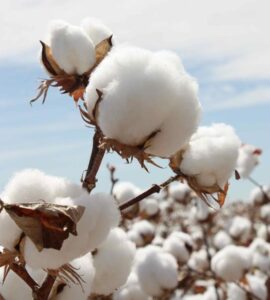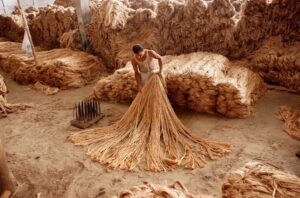What is Cotton?
Cotton is a type of material made from the cotton plant’s seed fibres. Textiles are made out of the fluffy plant material that surrounds the seeds. It is harvested by manufacturers, who then sift out the seeds and other detritus before spinning it into yarn for knitting or weaving. Cotton is a resilient, breathable, and soft fabric.
Compared to other natural fibres, its production costs are lower, and it is used to make a variety of textiles. It cleans up well in the washing machine because it absorbs water. There are numerous varieties and models of cotton bags that are printed and dyed as it is simple and easy to dye with natural colouring agents. Moreover, the prints do not deteriorate with time and after multiple washes. Cotton fabric and canvas can be easily produced in a range of stiffnesses, thicknesses, and fabric types according to the requirement and purpose. Both cotton-woven fabrics and machine-knit fabrics have distinct qualities and functional advantages. Cotton is a fibre that is easy to maintain no matter how it is spun, woven, or knit. It can be machine washed and dried without causing structural damage. Cotton clothing may shrink in the first few washes, but it will mostly keep its size and form throughout its lifespan.

(picture courtesy:cotton – Bing)
What is Jute?
It is one of the strongest natural fibres. It is the least expensive among all the fibres. It is a bast fibre like hemp and flax. Bangladesh and India are tropical nations with good jute plant yield. Jute fibre is made from the jute plant’s bark. It is grown in a traditional manner under circumstances similar to organic farming. It is used to create heavy ropes, curtains, paper, shoes, carpet backing, sacks, lounge chairs, and lunch bags, among other things. Additionally, it can be used with cotton to create high-end items like shirts, pants, coats, and other types of clothing. Jute has a long, silky fibre that is soft, glossy, and smooth.

(picture courtesy: jute – Bing images)
Differences between Cotton and Jute Fibres
• Cotton is known as “the king of fibres” while, Jute is known as the “golden fibre.”
• In terms of wearable and clothing products, Cotton is comfortable and soft than Jute. Jute cannot drape as well as Cotton.
• Cotton thrives well in warm climates with moderate amounts of precipitation. Jute grows well during the rainy season with abundance of water.
• Cotton is more expensive than Jute fibre.
• Jute has weak thermal conductivity and anti-static qualities compared to Cotton that has strong thermal conductivity.
• Compared to Cotton, Jute is a better material to use to create technological textiles that are rough and tough.
• White, creamy white, yellowish white, or grey are all possible colours for Cotton fibre. Contrarily, Jute fibre can white, off-white, yellow, brown, grey, or golden.
• Cotton canvas bags are lined using soft cotton fabric material or biodegradable wax which make them completely biodegradable and eco-friendly, while Jute bags are lined and laminated using LDPE plastics that are non-biodegradable.
Are Jute bags completely biodegradable?
Lamination process using low density polyethylene (LDPE) which is a soft, flexible, lightweight plastic material improves strength, waterproof, and durability properties of Jute bags. The LDPE plastic is mainly used for manufacturing various containers, dispensing and squeeze bottles, tubing, plastic parts of computer components, moulded laboratory equipment, and apparatus caps and closures. LDPE, when exposed to ultra violet light, is estimated to break down in a duration as long as 500 years with a conservative average time of 1000 years. If there is no exposure to a light source, for example at the bottom of a landfill, the plastic may remain intact for indefinite time period. Unlike polylactic acid (PLA) or kraft paper, LDPE takes roughly the same time to decompose as traditional plastics. Nevertheless, the absence of toxins when recycled makes it an eco-friendly alternative.
In terms of worldwide usage, Cotton and Jute are the first and second most popular natural cellulose fibres. Jute and Cotton are produced at the same rates throughout the world. Both the fibres are biodegradable, breathable, and water-absorbent. Bangladesh is the top producer of Jute, while India is the largest producer of Cotton. Jute is made from the resilient fibres supporting the stalks of the Jute plant, while Cotton is the soft cushioning surrounding the Cotton plant’s seeds. Since these fibres come from various plant parts, they serve very different purposes in nature. For example, Cotton fibres serve as nature’s packing seeds and are therefore very delicate, soft, and fluffy. Jute fibres are generally coarse and stiff because they must be tough enough to endure storms and wind. Burlap and heavy rope are made of jute, neither of which you want next to your skin. One may use Hemp or Linen to create a fabric made from sturdy plant stalk fibres that is not as coarse as Jute. Despite being derived from different plants (Hemp and Flax, respectively), they are fairly pleasant since they have considerably finer fibres than Jute.
